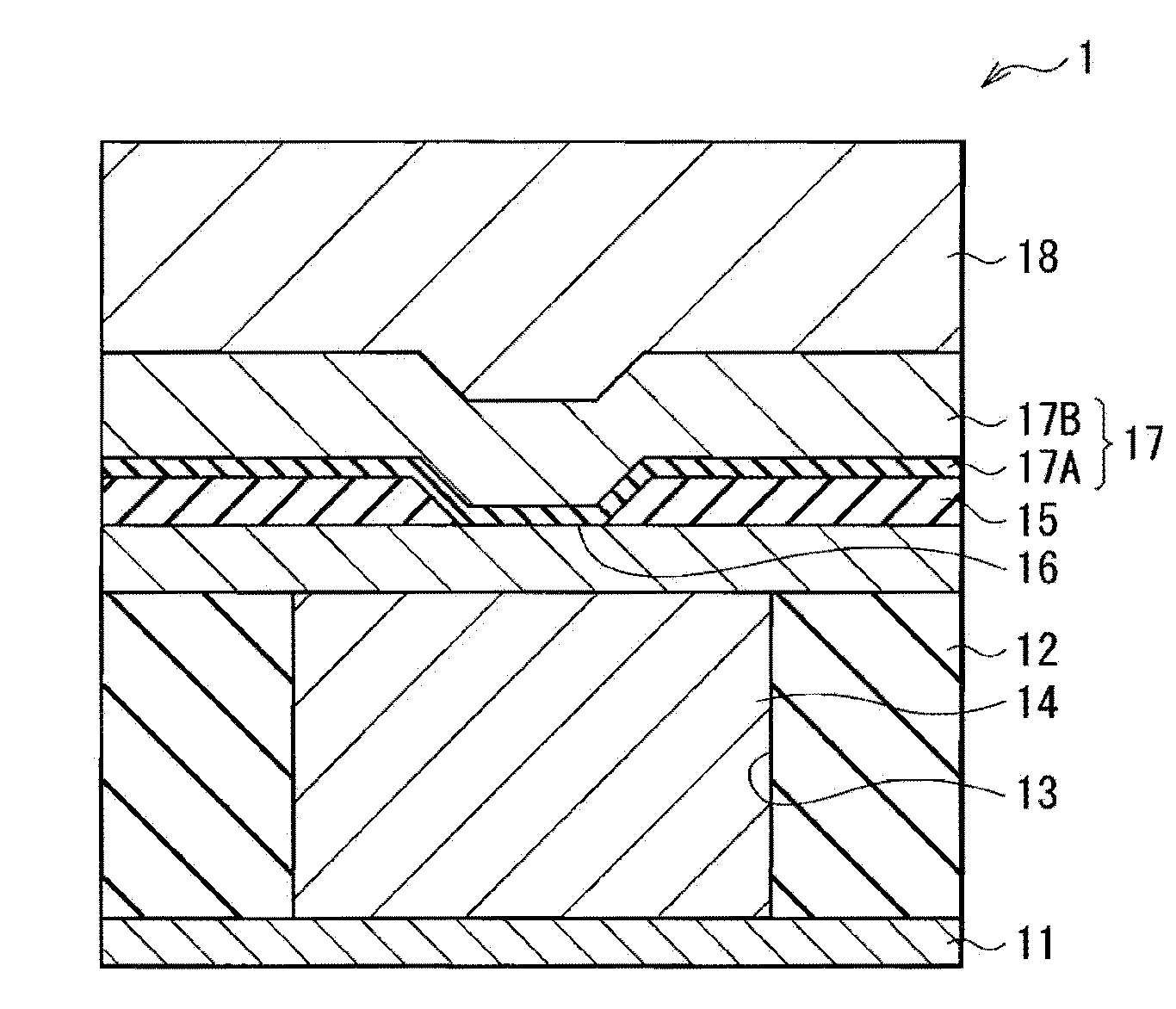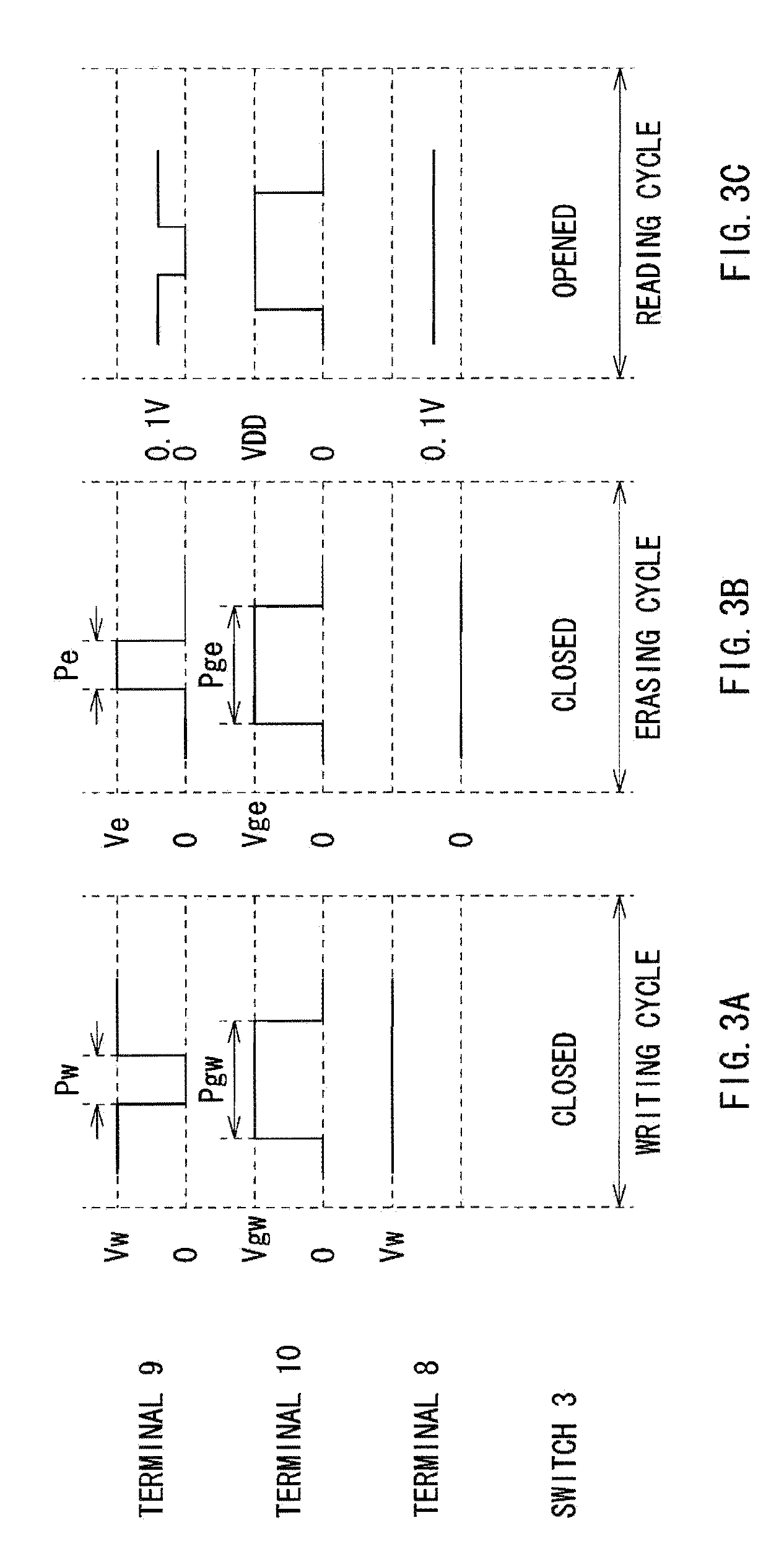Memory element and memory device
- Summary
- Abstract
- Description
- Claims
- Application Information
AI Technical Summary
Benefits of technology
Problems solved by technology
Method used
Image
Examples
example
Experiment 1
[0049]In order to investigate the effect of introducing oxygen into the above-mentioned ion source layer 17B, a memory element having a sectional structure of FIG. 1 was produced. The lower electrode 14 was made of W, the interlayer insulation film 15 was made of Si3N4, respectively, and the opening 16 of the interlayer insulation film 15 was formed into a round shape of 60 nm in diameter. A GdOx (gadolinium oxide) film was formed to the thickness of 2 nm as the high resistance layer 17B on the interlayer insulation film 15, using a sputtering system, then a Zr16Te44Al40Ox film was formed to the thickness of 45 nm as the ion source layer 17B using Zr, Te and Al (molar ratio: 16:44:40). At this time, a plurality of films were formed simultaneously by variously changing the argon-oxygen concentration. Subsequently, after forming a Zr film and a W film to the thickness of 20 nm as the upper electrode 18 on the ion source layer 17B, patterning was carried out.
[0050]Switching...
experiment 2
[0053]Next, in order to study a possibility of multiple-value recording for the above-mentioned memory element 1, repetitive characteristic for four values was examined on one memory element. Although the layered configuration of the element at that time was the same as the Experiment 1, the round dimension of the opening 16 in the interlayer insulation film 15 of the element was set to 30 nm in diameter. Sputtering conditions were set to the same as the above-mentioned Example 1. The four conductance values were set to 10 μS, 100 μS, 150 μS, and 200 μS, respectively. Recording for higher three conductance levels (100, 150 and 200 μS) was made by writing operation and recording for one lower conductance level (10 μS) was made by erasing operation.
[0054]FIG. 8 illustrates the repetitive characteristics for the four conductance values. Repetition was made by sweeping every pulse 10 sec, both in writing and erasing. The write voltage was set to 2.7 V. The gate voltage was increased eac...
experiment 3
[0055]In order to investigate an appropriate value of oxygen concentration to be introduced into the ion source layer 17B, the following films were formed by Ar sputtering on an oxide film silicon substrate so that elements of different oxygen concentration were produced. The Ar partial pressure at the time of forming Zr16Te44Al40Ox film was set to 0.25 Pa, and oxygen partial pressure was set to 0 Pa (no O2) for Comparative example 2 and 1×10−3 Pa (a little O2) for Example 3, and 9.5×10−3 Pa (a lot of O2) for Example 4 so that three kinds of samples were produced.
[0056]W film (film thickness: 30 nm) / GdOx film (film thickness: 1.2 nm) / Zr16Te44Al40Ox film (film thickness: 45 nm) / W film (antioxidant film) (film thickness: 5 nm)
[0057]Oxygen concentration in the depth direction was measured about those three kinds of test samples (Comparative example 2 and Examples 3 and 4) using XPS (X-ray photoelectron spectroscopy). The test samples were sputter-etched and their surfaces were analyzed...
PUM
 Login to View More
Login to View More Abstract
Description
Claims
Application Information
 Login to View More
Login to View More - R&D
- Intellectual Property
- Life Sciences
- Materials
- Tech Scout
- Unparalleled Data Quality
- Higher Quality Content
- 60% Fewer Hallucinations
Browse by: Latest US Patents, China's latest patents, Technical Efficacy Thesaurus, Application Domain, Technology Topic, Popular Technical Reports.
© 2025 PatSnap. All rights reserved.Legal|Privacy policy|Modern Slavery Act Transparency Statement|Sitemap|About US| Contact US: help@patsnap.com



